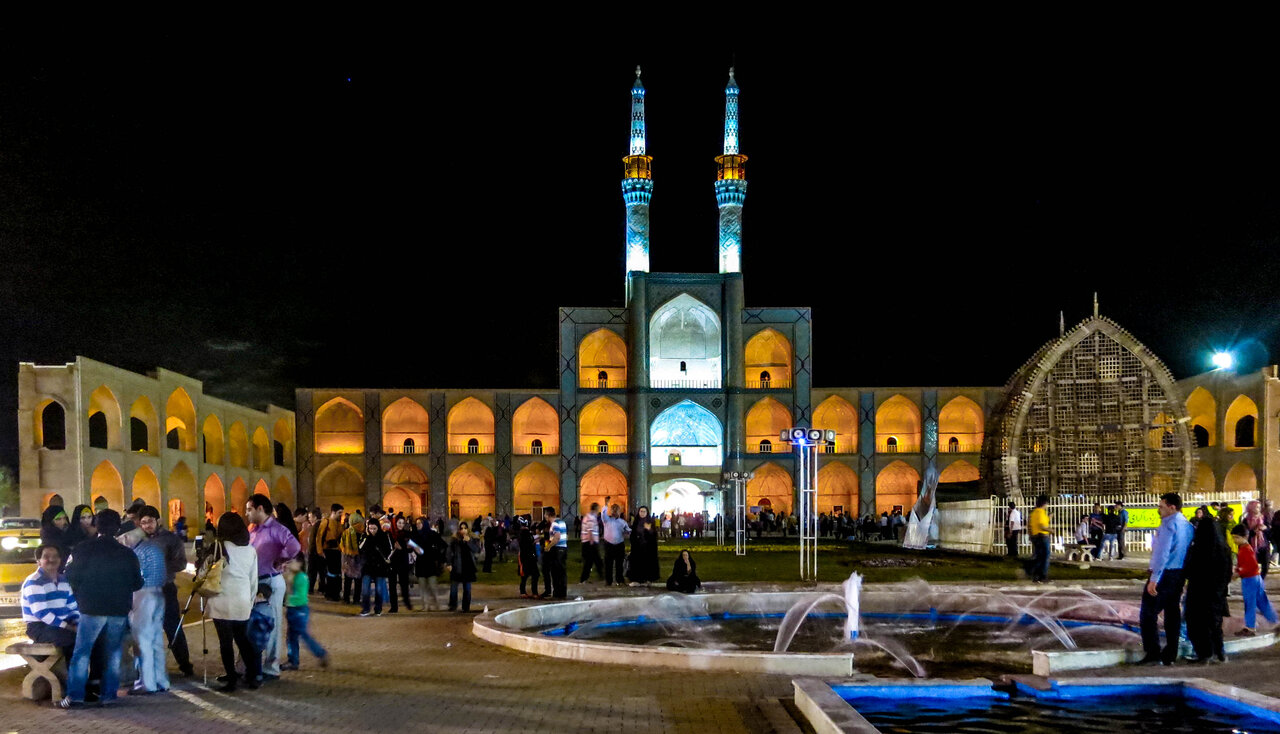Amir Chakhmaq complex: a glorious jewel of Yazd

TEHRAN - The Amir Chakhmaq complex, located in the heart of Yazd, a UNESCO-registered city in central Iran, stands as a magnificent symbol of architectural grandeur, cultural heritage, and historical significance.
This magnificent complex, featuring a square surrounded by ancient structures, has long been a center of social gatherings and celebrations, making it a must-visit destination for both locals and tourists.
The Amir Chakhmaq Square and its associated structures were initially built during the Timurid era by Amir Jalal Addin Chakhmaq, the ruler of Yazd, with the invaluable support of his wife, Seti-Fatemeh Khatoon. That initial establishment transformed the area into a cultural and spiritual hub. Over the centuries, additional features were added, and renovations carried out to preserve its charm and functionality. Today, it shines as a vibrant symbol of Yazd's rich history and attracts countless visitors each year. Here are glimpses of key attractions within the complex:
Amir Chakhmaq Mosque
Known as the New Jame Mosque, this is the oldest and one of the most significant structures in the square. It is renowned for its stunning Persian and Islamic architecture, which includes intricate mosaic inscriptions, brick artistry, fretwork, arabesque patterns, and Quranic carvings.
The mosque stands as a testament to the artistic and religious heritage of Yazd and is considered the second most important mosque in the city after the centuries-old Jame Mosque of Yazd.
Amir Chakhmaq Tekyeh
The Tekyeh, a structure with multiple rooms, was historically used for religious rituals and gatherings. Some rooms were reserved for the city’s rulers and women.
The iconic minarets of the Tekyeh once served as platforms for the Islamic call to prayer (Azan), adding a spiritual dimension to its architectural beauty.
Bazaar of Haji Ghanbar
This bustling bazaar is a cornerstone of Yazd's economic and cultural life. Divided into two parts during the Pahlavi era, the bazaar remains a vibrant center for commerce, offering fabrics, sweets, gold, carpets, and more.
The oldest section, Haji Ghanbar Bazaar, is said to date back to the 9th century of the Islamic calendar and preserves Yazd’s traditional craftsmanship, including sesame sweets and naturally dyed fabrics.
Amir Chakhmaq’s historical Nakhl
The historical Nakhl, located on the eastern side of the square, is a 450-year-old wooden structure resembling a cypress tree.
This giant symbolic coffin is used during the Muharram rituals in an event called Nakhl Gardani, a tradition that honors the martyrs of Karbala. The Nakhl is intricately carved and holds a special place in the hearts of Yazd's residents.
Seti-Fatemeh Khatoon mausoleum
The mausoleum of Seti Fatemeh Khatoon, the wife of Amir Chakhmaq, is another remarkable structure within the complex.
Its green-tiled dome and stunning interior design, adorned with mosaics and muqarnas on a stucco background, make it a site of both historical and aesthetic significance.
Water storage
The complex once had three gigantic water reservoirs, of which only two remain today.
These structures played a vital role in Yazd's water management system until modern piping was introduced about 40 years ago.
Other features
The complex also boasts nearby public baths, caravansaries, fountains, and a pond. In recent years, graves of unknown martyrs from the Holy Defense have been added, lending the square a solemn and spiritual atmosphere.
Amir Chakhmaq Complex is more than a historical site; it is a living testament to the rich cultural and architectural legacy of Yazd. Its intricate designs, vibrant bazaar, and spiritual elements combine to create a unique experience for visitors.
A UNESCO-listed destination
In July 2017, the historical core of Yazd, the provincial capital, was named a UNESCO World Heritage site. Yazd is regularly referred to as a delightful place to stay, or a “don’t miss” destination by almost all of its visitors. The city is full of mudbrick houses that are equipped with innovative badgirs (wind catchers), atmospheric alleyways, and many Islamic and Iranian monuments that shape its eye-catching city landscape.
Cultural heritage experts believe that Yazd is a living testimony to the intelligent use of limited available resources in the desert for survival. Water is brought to the city by the qanat system. Each district of the city is built on a qanat and has a communal center. Furthermore, the use of earth in buildings includes walls and roofs through the construction of vaults and domes. Houses are built with courtyards below ground level, serving underground areas. Wind-catchers, courtyards, and thick earthen walls create a pleasant microclimate.
The historical core of Yazd is chockfull of mudbrick houses, bazaars, public bathhouses, water cisterns, mosques, synagogues, Zoroastrian temples, and centuries-old gardens. From the divine point of view, the city enjoys the peaceful coexistence of three religions: Islam, Judaism, and Zoroastrianism.
Yazd is home to numerous qanats which have supplied water to agricultural and permanent settlements for thousands of years. The man-carved underground qanat system relies on snow-fed streams flowing down the foothills of surrounding mountains. The earliest water supply to Yazd is estimated to date from the Sassanid era (224 to 651 CE). However, many others have been continually repaired and used over time, and most surviving Ab-Anbars (traditional mudbrick cisterns) can today be traced to the late Safavid and Qajar periods.
AM
Leave a Comment